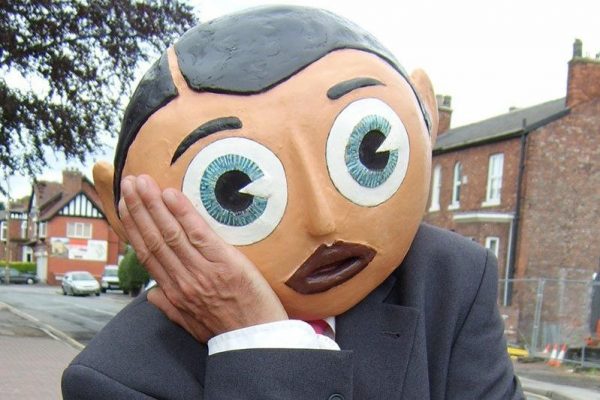@The Filmhouse, Edinburgh, from Mon 13 May
At the start of Steve Sullivan’s documentary Being Frank: The Chris Sievey Story, we are told, via caption in a child-like scrawl, that “most of what you are about to see was left in a damp cellar for many years”. The amusing irreverence and self-deprecation of such an opening is completely fitting for a documentary about Sievey, the Cheshire-born comedian and musician, most famous in the 80s and 90s for his eccentric, papier-mâché-headed persona, Frank Sidebottom. Throughout his career, Sievey seemed to occupy a nebulous space between being a mischievous, anti-establishment prankster who simply revelled in joyful absurdity for its own sake, and an anarchic, surrealist artist who secretly yearned for mainstream recognition and success, despite his signature ostentatiously unglamorous aesthetic, at the heart of which was a subversive celebration of domesticity and the quotidian. Synonymous with the Greater Manchester town of Timperley and responsible for inspiring Caroline Aherne’s Mrs Merton character, Sievey’s unique artistic vision could only ever have come out of the North.
The documentary combines home video footage, audio samples recorded by Sievey himself, and numerous talking heads, including his ex-wife, Paula; his children; journalist and former bandmate, Jon Ronson, and fellow performers John Cooper Clarke, Johnny Vegas and Ross Noble. Billed as “the unmasking of a creative genius”, the film goes some way to painting a fuller portrait of Sievey than previously held in public consciousness. Sievey’s famous refusal to “reveal” himself once he was in in character as Frank Sidebottom, and his insistence on continuing to wear the giant head, talking and acting as Frank to friends and colleagues – often hours after shows had ended – led to the widespread mythology that he was a ferociously private man who did not want to have his true identity exposed. According to the evidence presented by Sullivan, it seems more likely that Sievey’s blurring of these lines was just part of his commitment to his own subversive humour – further evidence of the true extent of his inherent eccentricity. The anarchist in him would no doubt have relished the fact that people often used to speculate as to which celebrity was really hiding under the giant head. It is also suggested, on more than one occasion, that the Sidebottom persona was a product of a psychological quirk in Sievey that veered towards the realm of genuine dissociative identity disorder.
It seems that, even for those close to Sievey, pinning down his precise motivations and feelings was a constant challenge. As a young musician, he appeared to seek a more straight-forward form of stardom than the one he would go on to achieve, but a combination of bad luck and his own impulse towards chaos and silliness meant these initial ambitions eluded him. The extent to which he was emotionally affected by early career setbacks is never entirely clear, nor indeed are we able to fully grasp the extent of the damage caused by other demons – alcoholism, drugs, depression, debt – that plagued him in later life before his death in 2010. It’s tempting to wonder if some of his behaviour and artistic choices were intentionally self-sabotaging; an odd and nihilistic form of emotional preservation. Certainly, he seems to have been as much of a charming enigma to his family as he was to the public.
The playful humour that pervades Sullivan’s film, its shrugging acknowledgement that Sievey was, to everyone, always a bit of a mystery, and its quirkily rough-and-ready, home-made presentation is all completely appropriate and make for decidedly engaging viewing. The passionate affection felt towards Sievey by those who knew him, worked with him or were simply inspired by his work is tangible and grants the film an impressive level of poignancy. In short, (Big Shorts?) Being Frank is really fantastic. You know it is. It really is.
